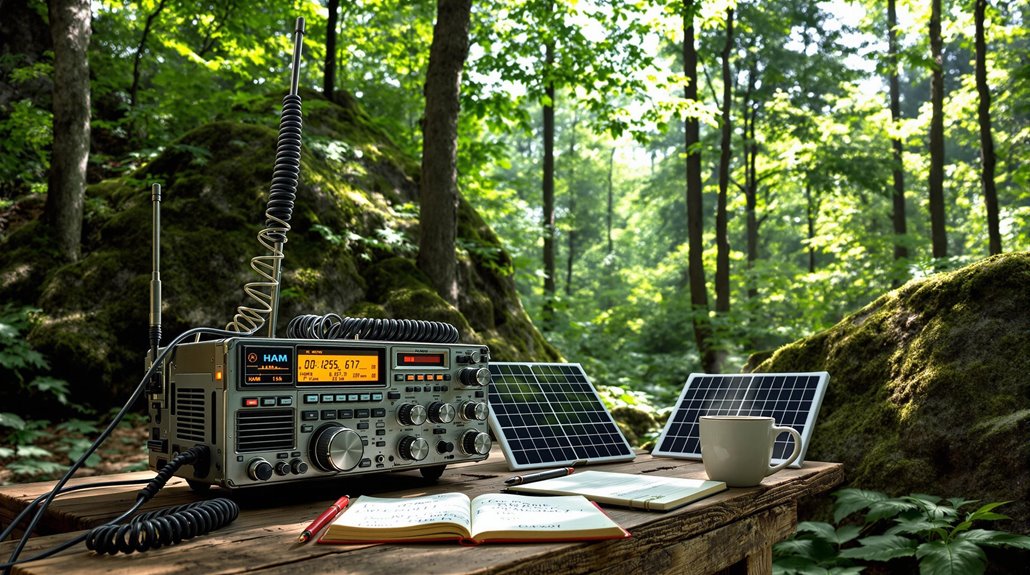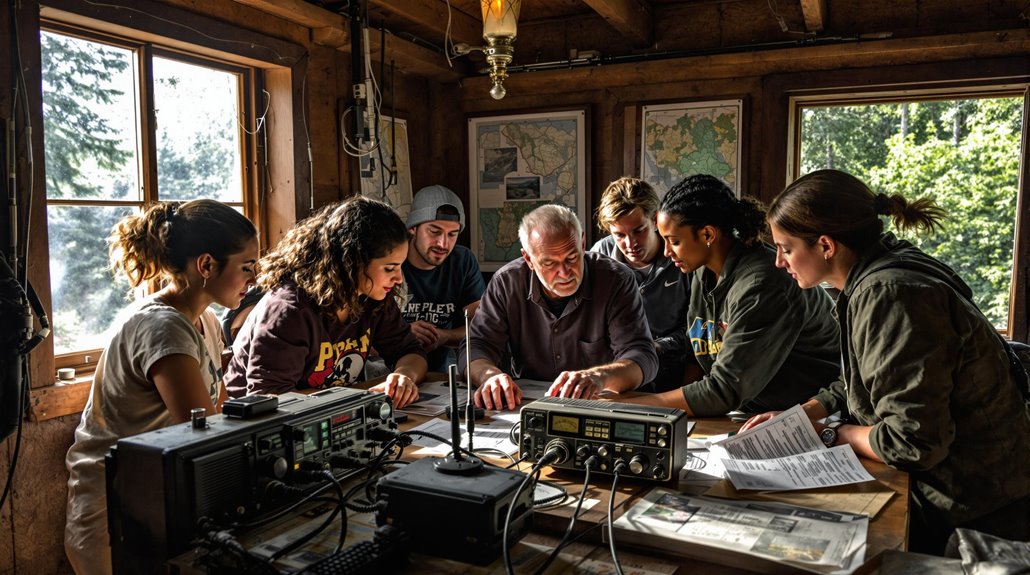The Role of HAM Radio in Off-Grid and SHTF Communication

In off-grid and SHTF scenarios, relying on HAM radio guarantees you're not left in the dark when modern communication systems fail. This adaptable tool operates on low power, allowing you to communicate locally and globally even during power outages. With simple setups like Slinky Dipole antennas and portable radios such as the Yaesu FT-817, you're prepared for different situations. Reliable power sources like solar chargers and battery banks keep your equipment running smoothly. Overcome challenges like difficult terrain or equipment failure with regular practice and skill development through local HAM clubs. There's much more to investigate and understand.
Benefits of HAM Radio in Emergencies
In emergencies, HAM radio shines as an vital lifeline when all else fails. During disasters like Hurricane Maria, which devastated Puerto Rico, traditional communication systems collapsed, leaving many isolated. However, ham radio operators stepped up, maintaining significant contact with emergency services. This resilience stems from the ability to operate on low power settings, such as 5 watts, guaranteeing you can communicate even when the power grid fails. As a licensed amateur radio operator, you possess a unique skill set that is indispensable during such crises. Your experience enables effective communication, not only locally but globally, thanks to simple setups like a Slinky Dipole antenna. This capability guarantees that, regardless of the situation, you're part of a radio community ready to assist. HAM radio's role in preparedness cannot be overstated. It bridges the gap when modern systems falter, making it a cornerstone of emergency planning. By being part of this community, you contribute to a reliable network that thrives even in the direst circumstances. Embracing the power of HAM radio means you're never truly cut off, no matter the disaster at hand. Additionally, solar flares can cause disruptions similar to EMPs, highlighting the importance of having reliable communication methods like HAM radio when modern systems are vulnerable.
Essential HAM Radio Equipment
When preparing for off-grid communication, having the right HAM radio equipment is vital. As an amateur radio operator, you'll need reliable ham radios like the Icom IC-718 for low-power operations and the Yaesu FT-817 for portability and internal battery use. These models are perfect for off-grid communication scenarios, guaranteeing you stay connected even when traditional networks fail.
To complement your radio setup, consider effective antenna options like the Slinky Dipole antenna. It pairs well with RG-8X coax, providing better impedance matching for your emergency setup. This combination will improve your communication capabilities, especially in challenging environments.
Power sources are another important component. Solar chargers, such as the Jackery Portable Power Station, and battery banks make sure your equipment remains operational during power outages. These options provide the sustained power necessary to maintain reliable communication when off-grid.
For thorough frequency coverage, utilize UHF and VHF frequencies to improve local communication, while HF frequencies allow you to send messages over longer distances. In emergencies, quick-deployment antennas made from household items and proper matching of antennas and cables are vital. Additionally, having emergency face masks as part of your urban SHTF gear ensures protection against pollutants and toxic fumes while operating your equipment. With the right equipment, you're well-equipped for efficient off-grid communication.
Setting Up for Off-Grid Use

Mastering the art of off-grid communication requires a strategic setup that guarantees reliability and efficiency. Start by choosing a ham radio like the Yaesu FT-817. It's compact, operates on internal batteries, and is designed for low power operation, making it perfect for off-grid scenarios. Pair it with a Slinky Dipole antenna, which is easy to deploy and can achieve global communication reach with minimal setup.
Next, secure a reliable power source. A solar charger or battery bank are excellent choices to make certain your ham radio equipment remains operational during extended outages. These power sources harness renewable energy, making them ideal for off-grid use and SHTF situations.
Confirm proper antenna matching to prevent excessive heat and potential equipment failure. This step is essential for maintaining efficient communication during emergencies. Mismatched antennas can lead to poor performance or even damage your gear, so take the time to get this right.
Finally, regularly test and maintain your equipment. Keep your solar panels and batteries in top condition to guarantee they're ready when you need them most. This diligence will keep your off-grid communication system reliable and ready for any situation. In addition to ham radios, satellite communicators offer a backup communication method during emergencies when other systems fail.
Overcoming Common Challenges
After setting up your off-grid communication system, it's important to recognize the common challenges that may arise. Terrain, weather, and solar cycles can greatly affect the reliability of your ham radio communication. As an operator, you should choose the right equipment and frequency ranges to guarantee peak performance. Low-power settings, even down to 0.5 watts, can be a lifesaver in limited power situations, allowing effective long-distance communication if your antenna is well-matched.
Antenna mismatches can cause excessive heat, leading to potential failure when you need communication the most. It's critical to verify your antenna is properly matched to avoid these issues. Quick-deployment antennas, crafted from common household items, can provide flexibility and adaptability during emergencies, helping you maintain communication when traditional setups aren't feasible.
Regular practice is fundamental for honing your skills. Drills help operators become familiar with their equipment and operational procedures, guaranteeing readiness for real emergencies. Remember, the more you practice, the more adept you'll become at managing your off-grid communication challenges.
- Rely on low-power settings for energy efficiency without sacrificing communication reach.
- Create quick-deployment antennas from everyday items for emergencies.
- Conduct regular drills and practice to stay prepared.
Community and Skill Development

Getting involved with local ham radio clubs opens up a world of opportunities for enhancing your skills and sharing knowledge with fellow operators. These clubs are indispensable for skill development, as they bring together enthusiasts who are passionate about emergency communication and preparedness. By joining a club, you'll engage in community drills and emergency response exercises that foster collaboration and allow you to practice your communication skills in realistic scenarios.
Online forums and resources are also essential for ongoing education. They keep you informed about the latest technologies and techniques in amateur radio communication. You'll find that resource sharing within the ham radio community creates a robust network, ready to support each other during emergencies. This collaboration is significant for effective communication when the grid is down.
Programs like those from the American Radio Relay League promote youth participation, ensuring that the next generation is equipped to carry on the tradition of ham radio and its important role in emergency communications. By participating in these initiatives, you're not just developing your own skills but also contributing to a community that values preparedness and skill development, ensuring efficient emergency communication for years to come. Additionally, it's crucial to have a communication plan established for family members during emergencies, ensuring everyone knows how to check in and stay connected.




